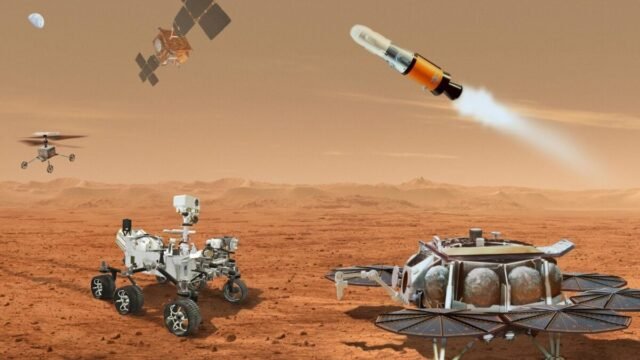For four years, NASA’s Perseverance Rover has been searching for possible signs of ancient life on the surface of Mars. It has found countless interesting features along its journey, including a rock with strange features discovered inside Mars’ Jezero Crater. Dubbed “Cheyava Falls,” the 2024 discovery immediately caught the attention of scientists on Earth because its spots suggested it could have a potential biosignature—a sign of life.
The rover went to work. The bot analyzed the rock composition and surface chemistry, and then earned the core the nickname “Sapphire Canyon.”
It looks like its hard work has paid off. On Wednesday, NASA scientists dropped the bombshell: Cheyava Falls may actually be the clearest sign of past life ever found on Mars.
“We were almost out of the crater. They were the last set of sedimentary rocks we were likely to look at on the mission,” Joel Hurowitz, a planetary scientist at Stony Brook University, told Gizmodo. He is the lead author of a new study detailing the findings, published in Nature.
“It was very surprising that this would have been a place where potential biosignatures jumped out of a cliff at us and said, ‘Hey, look here!'”
Of the 30 rock and regolith samples Perseverance has collected over the past four years, none show more promise as evidence for ancient life on Mars than this one. But in fact, confirmation of the biosignature depends on this sample’s return to Earth. At stake is one of the most enduring questions of our world: Is life on Earth really the only one?
“I don’t think we’ll ever make that determination without this sample in our hands,” Hurowitz said.
The case of a possible biosignature
The surface of Cheyava Falls has tiny black spots that NASA scientists call “poppy seeds” among the larger “leopard” spots. These features suggested to Hurowitz and his colleagues that chemical reactions had occurred at the time these sediments were deposited.
Analysis of the sediment revealed that Cheyava Falls is rich in organic carbon, sulfur, oxidized iron (rust), and phosphorus. This combination of chemical compounds could have provided a potential energy source for ancient microbes, but the researchers decided to probe the rock further.
Using Perseverance’s PIXL (Planetary Instrument for X-ray Litheism) instrument to map the surface chemistry of the rocks, they discovered a distinct pattern of minerals located at reaction fronts—points of contact where chemical and physical reactions occur—that corresponded to leopard sites. These sites also contained signatures of the iron-rich minerals vivianite and greigite.
On Earth, these minerals are often byproducts of reactions that occur when microbes metabolize organic matter, Hurowitz said. Importantly, it’s also possible that the spots on the cheyava are part of some other process, most likely through geothermal heating during the early stages of rock formation. “But there’s no real, clear evidence that the rocks were heated significantly,” Hurowitz said.
Researchers are far from ruling out these possible explanations – 140 million miles is actually the average.
“Deciding between a life-based and purely chemical origin requires laboratory analysis of the Sapphire Canyon sample,” Mario Parente, an associate professor of electrical and computer engineering at UMass Amherst, told Gizmodo. Parente was not involved in the study, but co-authored a corresponding view of the results.
Why Sapphire Canyon needs to return to earth
Laboratory analyses are “essential” to answering key questions that could confirm whether this is indeed a potential biosignature, Parente said. Techniques such as nanoscale mineral identification and high-resolution chemical mapping of the Sapphire Canyon sample could determine whether it does indeed contain vivianite, grigioite and carbon tightly bound to these minerals, he explained.
In addition, isotope analysis could reveal patterns called “fractionation,” which are signs of microbial activity. “Isotopes are one of the clearest ways to separate biology from geology,” Parente said. “I think these measurements could probably answer the question pretty clearly,” Hurowitz agreed.
However, there is a significant obstacle to such an effort: As it stands, NASA has no solid plans to go to Mars to retrieve samples from Sapphire Canyon or any of the Perseverance rover samples for that matter. The agency has been working with the European Space Agency to develop a multi-mission Mars sample return campaign to retrieve samples, but rising costs and complexity have stalled its progress.
The White House budget proposal for fiscal year 2026, released in May, threatened to cut funding for the effort, but in July the House Appropriations Commerce-Justice-Science Subcommittee moved to allocate $300 million to the program. That bill is still being processed, and it remains entirely possible that the missions could be canceled.
“I hate to see us not return samples,” Hurovich said. After spending more than 20 years working on Mars rover missions, he lays out what’s at stake: “It’s been this incredibly well-publicized exploration program to achieve this goal of trying to understand whether Mars was ever inhabited,” he said.
“With the data we have from The Rover, we’ll have this tantalizing clue that says, ‘Maybe,’ but we can’t answer the question.”















